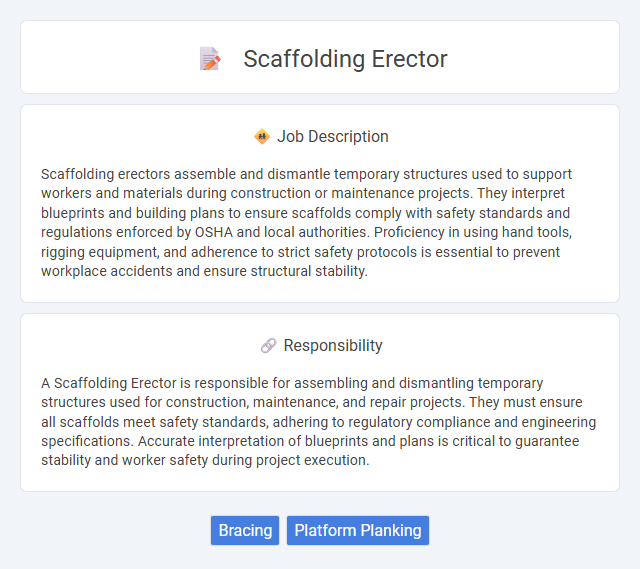
Scaffolding erectors assemble and dismantle temporary structures used to support workers and materials during construction or maintenance projects. They interpret blueprints and building plans to ensure scaffolds comply with safety standards and regulations enforced by OSHA and local authorities. Proficiency in using hand tools, rigging equipment, and adherence to strict safety protocols is essential to prevent workplace accidents and ensure structural stability.
Individuals with good physical health, strong stamina, and excellent balance are likely suitable for a scaffolding erector job due to the demanding nature of climbing and lifting heavy materials at heights. People with a fear of heights, poor coordination, or underlying health conditions affecting mobility may find this work challenging and potentially unsafe. Proper training and safety awareness would probably improve suitability, but physical fitness remains a critical factor.
Qualification
A scaffolding erector must possess certification in scaffold safety and extensive knowledge of OSHA regulations to ensure compliance on construction sites. Practical skills in assembling, installing, and dismantling various types of scaffolds, including supported and suspended systems, are essential for job performance. Physical fitness and ability to work at heights safely complement technical qualifications, enhancing overall site safety and efficiency.
Responsibility
A Scaffolding Erector is responsible for assembling and dismantling temporary structures used for construction, maintenance, and repair projects. They must ensure all scaffolds meet safety standards, adhering to regulatory compliance and engineering specifications. Accurate interpretation of blueprints and plans is critical to guarantee stability and worker safety during project execution.
Benefit
Working as a scaffolding erector likely provides substantial benefits such as consistent employment opportunities due to high demand in construction and maintenance projects. The job probably offers competitive wages and possibilities for overtime, contributing to increased earning potential. Safety training and skill development in this role may enhance long-term career prospects and job security.
Challenge
The scaffolding erector job likely presents significant physical and safety challenges due to working at heights and handling heavy materials. The role probably demands precise attention to detail to ensure structural stability and compliance with safety regulations. Workers may frequently encounter dynamic environments requiring adaptability and strong problem-solving skills.
Career Advancement
Scaffolding erectors develop specialized skills in assembling and dismantling temporary structures essential for safe construction work. Mastery of safety standards and certification in advanced rigging techniques enhance career advancement opportunities. Experienced erectors often progress to supervisory roles or project management positions within construction and industrial sectors.
Key Terms
Bracing
Scaffolding erectors specializing in bracing ensure the stability and safety of scaffold structures by installing and securing horizontal, diagonal, and cross braces. Proper bracing is critical to prevent scaffold collapse and withstand external forces such as wind and worker movement. Mastery of bracing techniques contributes to regulatory compliance and reduces workplace accidents on construction sites.
Platform Planking
Scaffolding erectors specialize in the safe and precise installation of platform planking, ensuring stable and secure walking surfaces on construction sites. They select and position high-quality planks according to load requirements and safety standards to prevent falls and structural failures. Mastery in platform planking is critical for maintaining scaffold integrity and protecting worker safety during elevated construction tasks.
 kuljobs.com
kuljobs.com